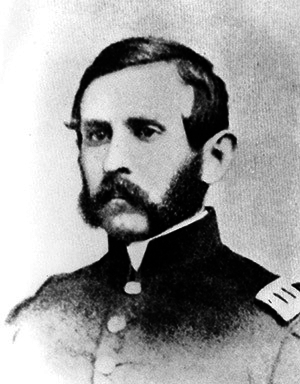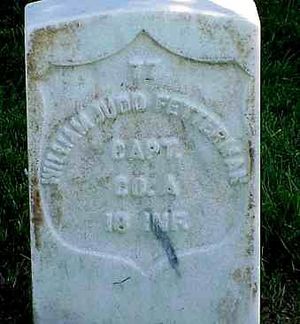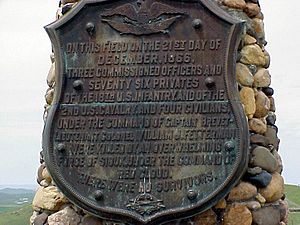William J. Fetterman facts for kids
Quick facts for kids
William Judd Fetterman
|
|
|---|---|

Capt. William J. Fetterman
|
|
| Born | 1833? New London, Connecticut (disputed) |
| Died | December 21, 1866 (aged 33) Near Fort Phil Kearny, Wyoming |
| Buried |
National Cemetery, Little Bighorn Battlefield National Monument
|
| Allegiance | Union |
| Service/ |
Union Army |
| Years of service | 1861 - 1866 |
| Rank | |
| Unit | 18th Infantry Regiment |
| Wars | American Civil War Indian Wars |
William Judd Fetterman (born 1833 – died December 21, 1866) was an officer in the United States Army. He served during the American Civil War and later in Red Cloud's War on the Great Plains. He is mostly known for the Fetterman Fight, where he and 80 soldiers under his command were killed.
Contents
Early Life and Family
William Fetterman was born in 1833 in Cheshire, Connecticut. His father, George Fetterman, was an Army Lieutenant who graduated from West Point. He served in the Army Artillery.
When William was born, his father was stationed at Fort Trumbull in New London, Connecticut. William's mother, Anna Judd Fetterman, passed away in 1835. A year later, his father left the Army and became a civil engineer in Pittsburgh, Pennsylvania. George Fetterman died in 1844.
Military Career and Service
Joining the Union Army
William Fetterman joined the Union Army on May 14, 1861. He quickly became a first lieutenant. He served with the US 18th Infantry Regiment throughout the American Civil War.
He was honored twice for his brave actions during the war. He finished the war as a lieutenant colonel.
Fighting in the Atlanta Campaign
In 1864, during the Atlanta campaign, Fetterman led the 2nd Battalion of the 18th US Infantry. This unit was part of a larger army group.
His battalion fought in battles like Buzzard Roost Gap and Resaca. Near Pickett's Mill, his battalion had 34 soldiers wounded. They also fought at the Battle of Kennesaw Mountain.
After July 1864, his battalion joined another unit. Fetterman then helped lead a successful attack at the Battle of Jonesborough. In this battle, his regiment lost 43 soldiers killed or wounded.
Post-War Service and Fort Phil Kearny
After the Civil War, Fetterman chose to stay in the Regular Army. He became a captain in the 18th Infantry Regiment.
In November 1866, his regiment was at Fort Phil Kearny. This fort protected people traveling to gold fields in Montana Territory along the Bozeman Trail. Fetterman was known for saying he could "ride through the whole Sioux nation" with just 80 soldiers.
The Fetterman Fight
On December 21, 1866, a large group of Cheyenne and Sioux warriors attacked a wood train near the fort. Famous leaders like Crazy Horse and Red Cloud were part of this group.
Even though he was new to fighting on the frontier, Fetterman led a group of 80 men. This group included Captain Frederick Brown, Lieutenant George Grummond, and other soldiers and scouts.
Fetterman was told not to go beyond Lodge Trail Ridge, which was out of sight of the fort. But he chased a small group of Sioux and was led into a trap. He suddenly faced about 2,000 Native American warriors. Within 20 minutes, Fetterman and all his men were killed.
This event became known as the Fetterman Fight. It was a major defeat for the U.S. Army. Fetterman's commanding officer, Henry B. Carrington, was at first blamed but later cleared.
William Fetterman was never married and had no children. He is buried in the National Cemetery at the Little Bighorn Battlefield National Monument.
Legacy and Recognition
In 1867, the Army named a new outpost in the Dakota Territory "Fort Fetterman" to honor him. There are also streets named Fetterman in Laramie, Wyoming.
An actor named Robert Fuller played William Fetterman in a TV show episode in 1966. The episode was called "Massacre at Fort Phil Kearny".
See also
 In Spanish: William J. Fetterman para niños
In Spanish: William J. Fetterman para niños



